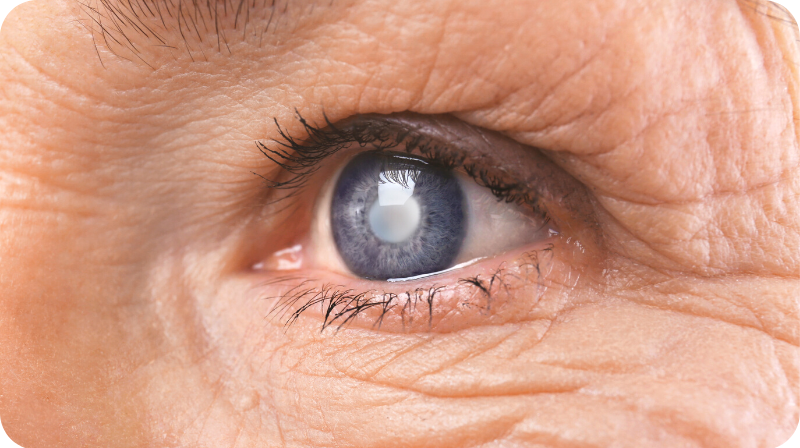Cataracts, the gradual, progressive clouding of eye lenses, are a common condition of aging. Your eye’s lens is positioned right behind the colored part of the eyeball. Although a cataract can occur and progress in different ways, all cases eventually interfere with normal vision. Left untreated, cataracts can block vision entirely. In most cases, both eyes are affected, although the incidence in each eye can progress at a different rate.

Cataracts are the result of compounding trauma to the eye and the natural age-related breakdown of proteins and fibers in the eye structure. The condition can be hastened or exacerbated by lifestyle factors, and it has a genetic component as well.
Fortunately, cataracts can be easily and safely remedied with a surgical procedure that replaces the damaged lens with an artificial version. Different synthetic lenses are available for replacement. The one you choose will determine both how expensive the procedure is, and how potentially adaptable the lens will be to different circumstances.
The Replacements
The answer to a vision-blocking cataract is to remove the damaged lens and replace it with a silicone or acrylic interocular lens (IOC). You can choose from the different types; the difference is cost (which usually translates to out-of-pocket expense) as it relates to increased functionality.
- Monofocal. This is the most basic, and the lens usually covered under insurance. Although the new lens will be clear, it will not correct pre-existing vision problems. However, some doctors use what is known as a “monovision” technique in cases where both eyes are being treated. A lens for close reading is placed in one eye, and a lens suitable for distances in the second. Monovision candidates are screened for applicability and many pre-existing conditions can disqualify a patient. The eyecare provider you use may also offer “accommodating-focus” monofocal lenses. These are a step up from plain monofocal lenses, reacting to eye muscle action to increase focal distance to some degree.
- Presbyopic. Functioning as bi- or tri-focal glasses do, these lenses have areas for near, mid-distance, and far view focus. The often correct pre-existing vision problems, alleviating the need for prescription glasses.
- Toric. This type of lens is specifically meant for astigmatism correction, which can mean you won’t need glasses after the surgery.
Side Effects, Aftercare, and Prevention
Because cataract surgery is now so common, there are relatively few side effects. You’ll likely need to heal for several days and up to a couple of weeks before you can see normally. Your doctor may have you use special eyewear or a patch during the healing period, and may also prescribe eyedrops to ensure against infection.
However, complications occur in a very small number of cases. Any patient experiencing significant ongoing pain, a loss of vision, extreme eye redness or swelling around the eye, or other alarming symptoms such as bright flashes of lights or predominant “floaters”, should consult a medical professional immediately. For more information on cataracts, treatments, and the most current thinking around the condition, consult the American Academy of Ophthalmology’s webpage on cataracts.
In the long run (or long before you get to late middle age, when cataracts often begin forming), it’s wise to make lifestyle changes to protect your eyes and improve eye health. Specifically:
- Stop smoking.
- Closely monitor and control diabetes.
- Maintain healthy weight.
- Monitor and control hypertension.
- Drink alcohol only in moderation, if at all.
- Wear eye protection whenever you’re in bright sunlight.
It’s easy to take your vision for granted, but lifelong eye health is maintained one day at a time. Do all you can to ensure eye and overall health, and you may avoid cataracts altogether. For more on how goji berries can help you do just that, check our previous post.







